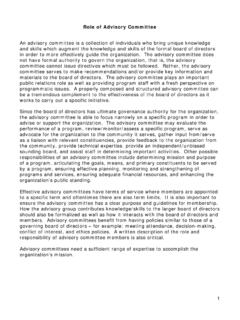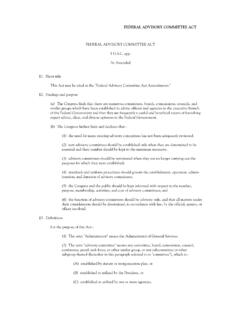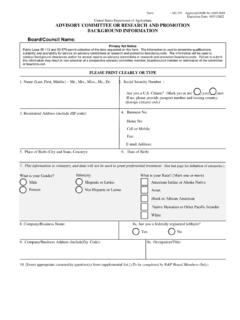Transcription of Prevention of Hepatitis B Virus Infection in the United ...
1 Morbidity and Mortality Weekly Report Recommendations and Reports / Vol. 67 / No. 1 January 12, 2018. Prevention of Hepatitis B Virus Infection in the United States: Recommendations of the advisory Committee on immunization practices Department of Health and Human Services Centers for Disease Control and Prevention Recommendations and Reports CONTENTS Disclosure of Relationships The 2016 2017 ACIP Hepatitis Vaccines Work Group members wish to disclose that they have no financial or New or Updated competing interests with the manufacturers of commercial products or suppliers of commercial services related to Hepatitis B (HepB) vaccines.
2 Content will not include any HBV discussion of the unlabeled use of a product or a product under Prophylaxis Against HBV investigational use, with the following exceptions: 13 use of Pediarix vaccine for infants born to Hepatitis B. surface antigen (HBsAg) positive mothers or mothers Future 25 with an unknown HBsAg status to complete the vaccine 25 series after receipt of a birth dose of single-antigen HepB. 25 vaccine and Hepatitis B immune globulin (HBIG);. alternate 3-dose vaccine administration schedules heeding to minimum intervals of 4 weeks between the first and second dose, 8 weeks between the second and third dose, and 16 weeks between the first and third dose.
3 Modified dosing regimens ( , doubling of standard dose and administration of additional doses) in certain circumstances ( , for persons with immunocompromising conditions); and antiviral therapy during pregnancy for the Prevention of perinatal Hepatitis B Virus (HBV) transmission. The MMWR series of publications is published by the Center for Surveillance, Epidemiology, and Laboratory Services, Centers for Disease Control and Prevention (CDC), Department of Health and Human Services, Atlanta, GA 30329-4027. Suggested citation: [Author names; first three, then et al.]
4 , if more than six.] [Title]. MMWR Recomm Rep 2018;67(No. RR-#):[inclusive page numbers]. Centers for Disease Control and Prevention Brenda Fitzgerald, MD, Director William R. Mac Kenzie, MD, Acting Associate Director for Science Joanne Cono, MD, ScM, Director, Office of Science Quality Chesley L. Richards, MD, MPH, Deputy Director for Public Health Scientific Services Michael F. Iademarco, MD, MPH, Director, Center for Surveillance, Epidemiology, and Laboratory Services MMWR Editorial and Production Staff (Serials). Sonja A. Rasmussen, MD, MS, Editor-in-Chief Martha F.
5 Boyd, Lead Visual Information Specialist Charlotte K. Kent, PhD, MPH, Executive Editor Maureen A. Leahy, Julia C. Martinroe, Christine G. Casey, MD, Editor Stephen R. Spriggs, Tong Yang, Teresa F. Rutledge, Managing Editor Visual Information Specialists David C. Johnson, Lead Technical Writer-Editor Quang M. Doan, MBA, Phyllis H. King, Jeffrey D. Sokolow, MA, Project Editor Paul D. Maitland, Terraye M. Starr, Moua Yang, Information Technology Specialists MMWR Editorial Board Timothy F. Jones, MD, Chairman William E. Halperin, MD, DrPH, MPH Jeff Niederdeppe, PhD. Matthew L.
6 Boulton, MD, MPH King K. Holmes, MD, PhD Patricia Quinlisk, MD, MPH. Virginia A. Caine, MD Robin Ikeda, MD, MPH Patrick L. Remington, MD, MPH. Katherine Lyon Daniel, PhD Rima F. Khabbaz, MD Carlos Roig, MS, MA. Jonathan E. Fielding, MD, MPH, MBA Phyllis Meadows, PhD, MSN, RN William L. Roper, MD, MPH. David W. Fleming, MD Jewel Mullen, MD, MPH, MPA William Schaffner, MD. Recommendations and Reports Prevention of Hepatitis B Virus Infection in the United States: Recommendations of the advisory Committee on immunization practices Sarah Schillie, MD1. Claudia Vellozzi, MD1.
7 Arthur Reingold, MD2. Aaron Harris, MD1. Penina Haber, MPH3. John W. Ward, MD1. Noele P. Nelson, MD1. 1 Division of Viral Hepatitis , National Center for HIV/AIDS, Viral Hepatitis , STD, and TB Prevention , CDC. 2 University of California, Berkeley School of Public Health, Berkeley, California 3 Division of Healthcare Quality Promotion, National Center for Emerging and Zoonotic Infectious Diseases, CDC. Summary Hepatitis B Virus (HBV) is transmitted via blood or sexual contact. Persons with chronic HBV Infection are at increased risk for cirrhosis and liver cancer and require medical care.
8 This report updates and summarizes previously published recommendations from the advisory Committee on immunization practices (ACIP) and CDC regarding the Prevention of HBV Infection in the United States. ACIP recommends testing all pregnant women for Hepatitis B surface antigen (HBsAg), and testing HBsAg-positive pregnant women for Hepatitis B Virus deoxyribonucleic acid (HBV DNA); administration of HepB vaccine and Hepatitis B immune globulin (HBIG) for infants born to HBV-infected women within 12 hours of birth, followed by completion of the vaccine series and postvaccination serologic testing; universal Hepatitis B vaccination within 24 hours of birth, followed by completion of the vaccine series.
9 And vaccination of children and adolescents aged <19 years who have not been vaccinated previously. ACIP recommends vaccination of adults at risk for HBV Infection , including universal vaccination of adults in settings in which a high proportion have risk factors for HBV Infection and vaccination of adults requesting protection from HBV without acknowledgment of a specific risk factor. These recommendations also provide CDC guidance for postexposure prophylaxis following occupational and other exposures. This report also briefly summarizes previously published American Association for the Study of Liver Diseases guidelines for maternal antiviral therapy to reduce perinatal HBV transmission.
10 Introduction contains updates to recommendations for the Prevention of HBV Infection in the United States. A list of frequently used Hepatitis B Virus (HBV) is transmitted through percutaneous abbreviations is provided (Box 1). ( , puncture through the skin) or mucosal ( , direct contact with mucous membranes) exposure to infectious blood or body fluids. HBV is highly infectious, can be transmitted in the absence of visible blood (1,2), and remains viable on New or Updated Recommendations environmental surfaces for at least seven days (3). Persons The following recommendations are new or updated: with chronic Infection ( , those with persistent Hepatitis B universal Hepatitis B (HepB) vaccination within surface antigen [HBsAg] in the serum for at least 6 months 24 hours of birth for medically stable infants weighing following acute Infection ) serve as the main reservoir for HBV 2,000 grams.

















